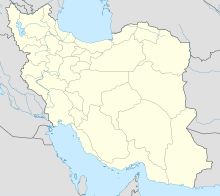
Back Ləklər (xalq) Azerbaijani لکلر AZB Lakk Catalan لەک CKB Lak (tribe) English Laq Spanish مردم لک Persian Lak (peuple) French Jolma Lak KGE Kurdên lek Kurdish
Die Lak, Alak oder Lek sind ein lurischer Stamm[1][2][3][4][5][6] oder die südöstliche Gruppe der Kurdenstämme in Kermānschāh, Lorestan, Elam und Hamadan.
Ihr Siedlungsgebiet wird auch Lakistan (deutsch Land der Laks) genannt. Laki gilt als Dialekt des Lurischen[7][8][9] oder des Südkurdischen.
Zu den die Sprache der Lak sprechenden Stämmem gehören die Turkaschvand in Luristan.[10][11]
- ↑ ایزدپناه، ح. فرهنگ لکی، مؤسسه فرهنگی جهانگیری، تهران ۱۳۶۷خ، ص ده (مقدمه)
- ↑ The Lurs of Iran. Cultural Survival, März 1985, abgerufen am 21. September 2015.
- ↑ امان الاهی بهاروند، سکندر. قوم لر. تهران: آتیه، 1393
- ↑ E. J. Anonby: Kurdish or Luri? Laki’s Disputed Identity in the Luristan Province of Iran. In: Kurdische Studien, 4/1-2, 2004, S. 5–20.
- ↑ S. Amanolahi: Reza Shah and the Lurs: The Impact of the Modern State on Luristan. In: Iran & the Caucasus, 6(1/2), 2002, S. 193–218, JSTOR:4030721
- ↑ Erik John Anonby: Update on Luri: How many languages? In: Journal of the Royal Asiatic Society (Third Series), 13, 2003, S. 171–197, doi:10.1017/S1356186303003067.
- ↑ William J. Frawley, William Frawley: International Encyclopedia of Linguistics& 4-Volume Set, Volume 1. Oxford University Press, 2003, ISBN 978-0-19-513977-8, S. 310.
- ↑ Albrecht Klose: Sprachen der Welt. De Gruyter, 2001, ISBN 978-3-598-11404-5, S. 227.
- ↑ B. Grimes (ed.): Luri. In: Ethnologue. 13th edition. Dallas 1996, S. 677. M. Ruhlen: A Guide to the World’s Languages. Stanford 1991, S. 327.
- ↑ Frank Hole, Sekandar Amanolahi-Bahanvand: Tribal Pastoralists in Transition. The Baharvand of Luristan, Iran (= Anthropological Papers. Nr. 100). The Museum of Anthropology, Ann Arbor 2021, ISBN 978-0-915703-99-9, S. 179.
- ↑ Vgl. auch Nasrollah Kasraian, Ziba Arshi: Our Homeland Iran. Sekké Press, Iran 1990; 10. Auflage ebenda 1998, ISBN 964-6194-91-5, Foto-Nr. 116 (Torkāshvand trib, Luristān).
